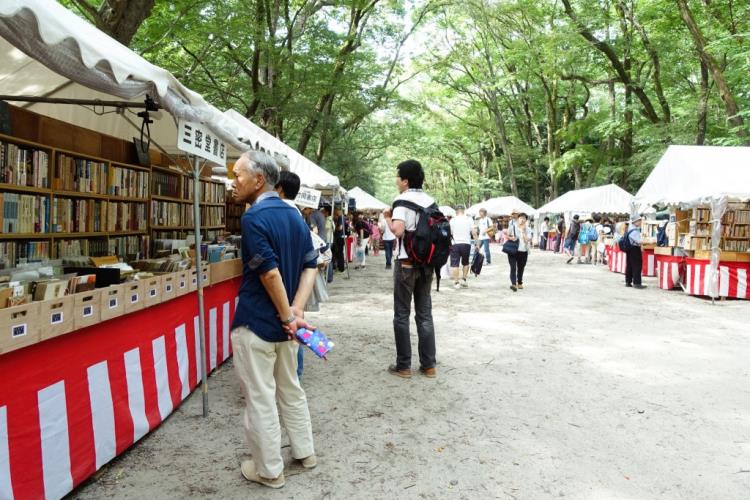Japan-based writer and traveller, specialising in design, lifestyle and travel journalism. Ron previously served as an editor of MING Magazine, ELLE Decoration and CREAM.

It’s important to pick the right day to visit Kyoto. I am not talking about the cherry blossom season or the fall foliage, but the 15th or 25th of every month, or any other days when flea markets are held, which turn quiet temples or shrines to a lively marketplace.
The Used Book Fair held in Shimogamo Tadasunomori in August is one of my favourite flea markets. Tadasunomori is the land of tranquility. With the size of 124,000 sqm, this piece of forest boasts hundreds of old trees and a meandering stream, and therefore summer heat can’t really penetrate the woods. Organised by Kyoto Koshoken (Kyoto Antique Books Society), the fair is held three times a year and each is held in a different location. While it is held in the Miyako Messe (Kyoto International Exhibition Hall) during spring times, the fall edition is held in Hyakumanben in Chionji Temple. And the summer edition, which is called Shimogamo Noryo Furuhon Matsuri in Japanese, is held in Shimogamo Tadasunomori. Used books (furuhon) are of course the major attraction of the fair, but noryo, literally to enjoy the cool while walking outside, is also the highlight. The name of the fair simply reflects that people in Kyoto see reading as one of their leisure activities.
The book fair held in Miyako Messe is an indoor activity. There aren’t any other activities apart from reading. However, the fair held in Shimogamo Tadasunomori is an outdoor one, and the atmosphere is more relaxing. Dozens of secondhand booksellers from Kyoto set up booths that straddle the forest. At the end of the booths, like any other festive fairs, there are food stands that serve snacks and beverages. Behind the booths you will see people picnicking under the trees. People sit on the ground and read books they just bought, as well as enjoy their bento box lunches. Shimogamo is open to public year round, but it’s especially lively on the market days, and people enjoy this primeval forest in the city to a tee.
There are several creative markets held monthly in Kyoto. For instances, there are flea markets held in Kamigamo Shrine and Umekoji Park. The most well-known market is the handicraft market held in Chionji Temple on the 15th of every month. Like the Used Book Fair held in Shimogamo, the handicraft market held in Chionji Temple is also a temple market. However, two of them have totally different goals. The Used Book Fair in Shimogamo aims to give secondhand booksellers in Kyoto an opportunity to exchange ideas and to make secondhand books as a more visible part of culture. The handicraft market in Chionji Temple is hoped to attract people to visit the temple again.
Most of the temples and shrines in Japan are funded by donations. Such funding is essential to the restoration of the architecture, care and maintenance of the gardens as well as other upkeep costs. In the past, Japanese people frequented temples as these places used to serve as a playground for kids. But now, people visit temples less than before because kids prefer staying indoors or playing in parks. Without frequent visitors, temples receive less donations and this has thrown this traditional Japanese custom into a state of crisis. This, therefore, gave birth to the handicraft market in Chionji Temple. It is hoped that the market can be a medium to connect people to the temple again.
Also, handicraft markets play an important role in promoting the cultural and creative industries. The market in Chionji Temple, for instances, was founded in 1987. At the beginning only 86 vendors participated in the market. Now, 400 artisans from all over Japan take part in it every month. Some of them already have their own shops, and some are students who want to test the waters to see if their designs have any market. One of the problems of running an online store is that your customers can’t see the real products and they have doubts about the quality. Running a brick-and-mortar store or a pop-up store in a department store requires an enormous capital outlay. Setting up a booth in the handicraft market only requires several thousand yens to rent a space. With such a low capital cost, vendors can directly reach their customers, talk to them and know how they see their products. This is an especially precious opportunity for young artists and designers.
I have befriended with some renown potters in Japan and they all coincidentally said that it’s easier to make a living from pottery making now than it used to be because people are giving more attention to tableware and table setting (thanks Instagram). Moreover, there are more channels to promote one’s artwork now, and crockery outlets are popping up, to the extent that even boutiques start selling ceramics. Handicraft markets, needless to say, are vital for artists to make their debut. To promote the cultural and creative industries, as well as to allow young artists and their artwork to be seen, participating in a handicraft market is probably the simplest and most cost effective way to achieve this.